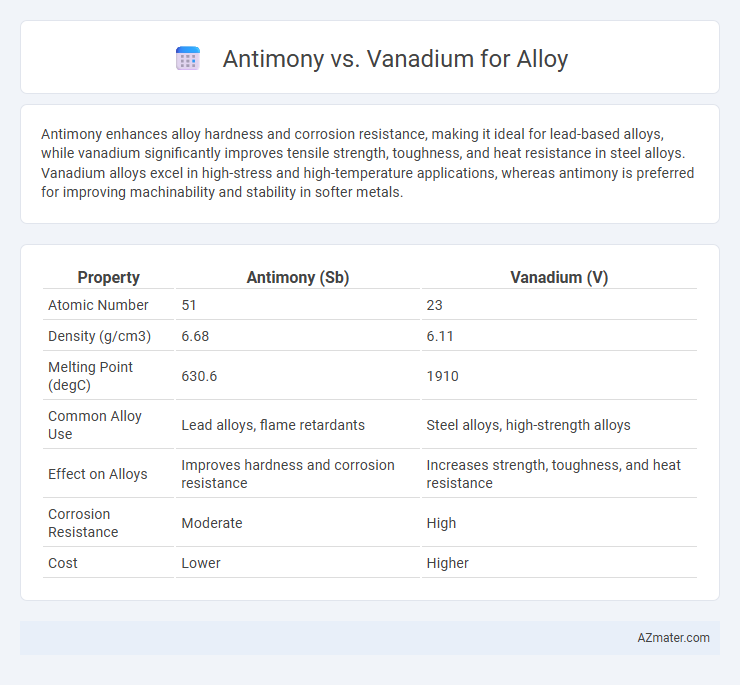Antimony enhances alloy hardness and corrosion resistance, making it ideal for lead-based alloys, while vanadium significantly improves tensile strength, toughness, and heat resistance in steel alloys. Vanadium alloys excel in high-stress and high-temperature applications, whereas antimony is preferred for improving machinability and stability in softer metals.
Table of Comparison
| Property | Antimony (Sb) | Vanadium (V) |
|---|---|---|
| Atomic Number | 51 | 23 |
| Density (g/cm3) | 6.68 | 6.11 |
| Melting Point (degC) | 630.6 | 1910 |
| Common Alloy Use | Lead alloys, flame retardants | Steel alloys, high-strength alloys |
| Effect on Alloys | Improves hardness and corrosion resistance | Increases strength, toughness, and heat resistance |
| Corrosion Resistance | Moderate | High |
| Cost | Lower | Higher |
Overview of Antimony and Vanadium
Antimony is a brittle, silvery metalloid primarily used to enhance hardness and corrosion resistance in alloys such as lead-acid batteries and flame retardants. Vanadium, a transition metal known for its high strength and resistance to oxidation, significantly improves the tensile strength and toughness of steel and titanium alloys. Both elements play critical roles in alloy production, with antimony providing stability and vanadium contributing to mechanical performance.
Chemical Properties Comparison
Antimony, with atomic number 51 and electron configuration [Kr] 4d10 5s2 5p3, is a metalloid known for its high density (6.697 g/cm3) and moderate melting point of 630.63degC, exhibiting poor electrical conductivity but significant resistance to oxidation. Vanadium, atomic number 23 and electron configuration [Ar] 3d3 4s2, is a transition metal characterized by a higher melting point of 1910degC, excellent corrosion resistance, and strong tensile strength due to its electron-rich d-orbitals promoting metallic bonding. In alloys, vanadium enhances hardness and thermal stability, while antimony is typically used to improve machinability and corrosion resistance, reflecting their distinct chemical reactivities and bonding behaviors.
Roles in Alloy Formation
Antimony enhances alloy properties by improving hardness, corrosion resistance, and machinability, making it essential in lead and tin alloys for batteries and soldering applications. Vanadium contributes significantly to steel alloys by increasing strength, wear resistance, and toughness through grain refinement and carbide formation. Both elements play critical roles in alloy formation, with antimony primarily modifying physical durability and vanadium optimizing mechanical strength.
Mechanical Strength Contributions
Antimony enhances alloy hardness and wear resistance by forming stable intermetallic compounds that improve tensile strength and reduce brittleness. Vanadium contributes significantly to mechanical strength through carbide precipitation, which refines grain structure and increases toughness and fatigue resistance. Alloys with vanadium typically exhibit superior strength-to-weight ratios, while antimony is more effective in improving surface hardness and corrosion resistance.
Corrosion Resistance Differences
Antimony enhances alloy corrosion resistance by forming a protective oxide layer that improves durability in acidic and alkaline environments. Vanadium contributes to corrosion resistance through its ability to stabilize the alloy's microstructure, particularly in stainless steels, increasing resistance to pitting and crevice corrosion. Alloys with vanadium generally exhibit superior performance in high-temperature and chemically aggressive conditions compared to those with antimony.
Impact on Alloy Hardness
Antimony enhances alloy hardness by promoting solid solution strengthening and improving wear resistance, making it effective in lead- and tin-based alloys. Vanadium significantly increases alloy hardness through carbide formation and grain refinement, particularly in steel alloys, resulting in superior strength and toughness. Vanadium's impact on hardness is generally more pronounced than antimony's due to its ability to form hard, stable carbides within the metal matrix.
Thermal Stability in Alloys
Antimony enhances thermal stability in alloys by improving oxidation resistance and maintaining strength at elevated temperatures, particularly in lead-based and bronze alloys. Vanadium contributes to thermal stability through the formation of stable carbides and nitrides, which increase high-temperature strength and creep resistance in steel and titanium alloys. Comparing both, vanadium alloys generally exhibit superior thermal stability in high-stress, high-temperature environments, while antimony's benefits are more pronounced in corrosion-resistant and lower-temperature applications.
Industrial Applications: Antimony vs Vanadium
Antimony enhances alloys by improving hardness, corrosion resistance, and flame retardancy, making it valuable in lead-acid batteries, bearings, and cable sheathing. Vanadium significantly increases alloy strength, toughness, and heat resistance, with critical applications in aerospace, automotive, and tool steels. Industrially, vanadium's ability to refine grain structure and improve fatigue resistance often surpasses antimony in high-stress environments, while antimony excels in corrosion protection and flame retardant properties.
Environmental and Health Considerations
Antimony, used in small quantities in alloys, poses significant environmental and health risks due to its toxicity and potential to contaminate water sources through mining and industrial processes. Vanadium, while also requiring careful handling, generally exhibits lower toxicity and environmental persistence, making it a more environmentally sustainable choice for alloy production. Proper waste management and exposure controls are critical for both metals to minimize ecological impact and protect worker health during manufacturing and recycling.
Cost and Availability Analysis
Antimony and vanadium differ significantly in cost and availability for alloy production, with vanadium being more abundant and generally less expensive due to its widespread mining from sources like titaniferous magnetite ores. Antimony, primarily sourced from limited deposits in China and Bolivia, commands higher prices and exhibits greater market volatility, impacting alloy manufacturing budgets. The cost-efficiency of vanadium alloys benefits industries demanding corrosion resistance and strength, while antimony alloys are favored for flame retardancy despite higher raw material expenses.

Infographic: Antimony vs Vanadium for Alloy
 azmater.com
azmater.com